Family Affair
In the fertile valleys of Sonoma County, all small wineries are not created equal
By Marina Wolf
IN FRONT of their miniature winery building on the outskirts of Windsor, Don and Lynne Albini perch atop of ladders, pouring clusters of purple grapes into the hopper of the lone crusher, which collects the pulp for the 1998 Albini Family Vineyards merlot. Below, Lynne's mother, Marie, rakes aside the stems that spill out into a platform cart, while her Marie's husband, Ted, sprays out the emptied crates and chats amiably about his hernia and their old neighborhood back in Ohio.
For all this hard work, Lynne's parents get some good times and a few bottles of the Albini annual output, one of the smallest for an individual bonded site in Sonoma County: 500 cases.
Approximately 25 miles to the north in Geyserville, Mike Draxton and his wife, Carol, are starting up their harvest of some 90 acres of merlot and sauvignon blanc. That's a fair amount of grapes, but most of it is being sold to other winemakers. Mike holds back just enough to take up to the Associated Vintage Group facility in Hopland, where he will use the fully equipped crushing facility to produce one of the smaller labels that AVG works with. The Draxton label this year will cork just 1,400 cases.
Meanwhile, in a sun-dappled vale in Forestville, fresh green rows of newly planted vines and an explicit sign--no tasting room, no visitors--guard the road to Hartford Court Winery, one of the smallest and brightest jewels in the Kendall-Jackson crown. The buildings visible through the trees hold the beginnings of the 1998 harvest, which will ultimately be transformed into fewer than 6,000 cases of high-end, sought-after bottlings of pinot noir and zinfandel.
Fruits of their labor: For Windsor winemakers Dan and Lynne Albini, with daughters Eva, far left, and Danielle, far right, small independently owned wineries are synonymous with family.
All of these wineries fall into the general category of "small wineries": producing under 10,000 cases annually. In Sonoma County alone, there are about 60 wineries producing under 5,000 cases a year, according to the calculations of the Wine Industry Symposium in Napa. Small wineries constitute over a third of the licensed wineries in the county, and some, like the Rafanelli and William Selyem labels, have risen to fame as "boutique wineries," with their wines virtually impossible to get, and well worth the search.
But the varying origins of these small-output wines beg the question: What does "small winery" really mean?
For Don and Lynne Albini, the term translates into "family." Their two teenage daughters are bent on joining the business after college, and already join in on the vineyard chores between school and a social life. And the three-acre farm swarms with relatives and friends during the fall harvest and crush, and later the bottling. Though there are a few investors, and Lynne still takes hairdressing clients on the side, the Albinis are, in fact, making most of their living off of 500 cases a year, sold through the mail to a dedicated list of individuals and restaurants around the country.
It wouldn't be possible, says Don, but for the fact that they built it all from the ground up over the course of 20 years: the house, the winery, the vineyard, everything. His uncle built the fireplace, his father helped build the house. The equipment is all paid for, and all the storage is on-site. "Most people don't have that opportunity," Albini says simply. "They're making payments because they had the winery built and the vines planted [for them]."
The barn-raising approach to building a winery not only saves money, but is also essential to the Albinis' way of life. They moved to the area when it was still all country, so that they could be raised in an agricultural environment. "The United States was all agrarian to begin with," he points out. "And I don't think anything can tie you closer to the earth and to family values than ranching and farming."
Grape expectations: Lynne Albini inspects what comes out the other side of the crusher.
THIS IS THE WAY wine always has been produced until recently. Many of the region's winemaking giants--Mondavi, Sebastiani--are still owned and operated by family members, working in marketing, as vice presidents, or even as resident winemakers. But as business realities change in the face of growing consolidation, so does the world of family-owned wineries.
Locally, several branches of the sprawling Kendall-Jackson family tree fall well within the definition of small wineries. There's Hartford Court, for one, plus Cardinale and Lokoya, which annually produce only 5,000 cases and 3,000 cases, respectively, and command upwards of $70 a bottle. On paper, and in most functions, these wineries each stand on their own as independent businesses. But members of the K-J family of small wineries operate differently from the traditional small winery in several important ways.
First of all, the small wines are marketed collectively in an Artisans and Estates portfolio, which gives them prime placement in the well-lit tasting room in the palatial--and very busy--Kendall-Jackson Visitors Center in Fulton. Outside of tasting-room sales, the powerful K-J marketing and distribution machine can push the wines far more vigorously than any single winery of that size could manage or justify on its own.
Then there are the recurring expenses--the barrels, the bottles--which hit small wineries harder than large ones. The old saying--"You have to start out with a large fortune to make a small fortune in winemaking"--isn't much of a joke, though small winemakers still laugh. Most of them don't have even a small fortune, so they're happy just to stay afloat.
Graham Parnell, editor of Vineyard and Winery Management magazine, recalls talking to a small winery owner who felt stretched by buying four French oak barrels at $700 apiece. "Then I took a group on a tour to Rodney Strong, with 23,000 barrels," recounts Parnell. "They're replacing at least a third of them with new oak. So we're talking big, big money."
Jim Caudill, vice president of public relations at Kendall-Jackson, mentions glass purchase specifically when asked about the material advantages that the K-J small wineries might have over their independent counterparts. "When we buy bottles and can get a better deal buying as a unit, we do," says Caudill.
Michael Amsler
He believes, however, that small wineries still have the edge. "The wine business is not like any other business. There's nothing worse than being successful," he says. "The wine industry is based on discovery and romance. Any advantage gained by working together as a coalition sort of evaporates against that."
Don Albini would disagree with that assessment, and it isn't sour grapes: His merlot inevitably sells out. But he still is vociferous on the subject of larger wineries that own smaller wineries. One problem, he alleges, is that newly purchased small wineries may have their output slowly increased, and possibly change their product as well, so that people may think they're still buying from a 2,000-case winery when in fact the count is now closer to 10,000, while the taste may have gradually mainstreamed. Since case counts are not listed on labels and in reviews as much as they once were, he says, "people don't know that instead of being a little handmade wine, it's now more of a commercial entity.
"These are the kind of things that threaten small wineries that are actually small wineries. We kind of disappear," adds Albini. "As big corporations buy up small wineries, we suddenly become one out of a thousand small wineries."
THE PROLIFERATION of small-output labels may be a problem for the handcrafted, family-owned establishments, but it's not malicious, says Gerald Boyd, who is the wine writer for the San Francisco Chronicle and has a fairly pragmatic take on the big winery/small winery connection. "The reason why [the wine companies] are buying these wineries is to diversify their portfolio," he explains. "They want a [small] winery in Sonoma, they want a sparklingwine producer, they want something on the central coast. This is the idea of having a complete portfolio so that you can cover all ground."
Furthermore, he says, the large companies want to keep making high-quality wines through those small labels: "They're not in it to dumb down the business."
One problem in discussing the small-winery arena is that it's impossible to determine the extent to which small wineries have been bought up or created by larger establishments over the years. Nobody keeps track of labels and case counts except the federal Bureau of Alcohol, Tobacco, and Firearms, which is not conducting any sort of longitudinal study on the subject, and declined to supply statistics. But many wine experts would agree that the number of small labels, defined by case count alone, has increased over the past decade.
One factor may be the emergence of custom-crush facilities such as the Associated Vintage Group. The main office in Graton, occupying several blocks of downtown space, has the polished appearance of many a larger winery, with meeting rooms and a calm, spacious lobby drawing one's attention away from the gear-grinding and grape-crushing that is transpiring out back.
Allan Hemphill, president and managing director, was going to give a quick tour of the compound, but was called away to an emergency at the Hopland facility. He did arrange, however, to leave his visitor a publicity packet, which describes a huge organization offering smaller winemaking entities the chance to profit, as Kendall-Jackson wineries do, from economy of scale. With four facilities in Sonoma and Mendocino counties, AVG offers a wide range of production, marketing, and administrative services to winemakers and wineries, effectively lowering the threshold of capital investment to allow start-up wineries to get in on the ground floor.
Michael Amsler
That's how Mike Draxton got started. Though he and his wife owned their property and vineyard outright, they just couldn't see their way clear to buying pricey equipment for such small lots, when a perfectly good set-up was available just down the freeway. Draxton's ambitions may be irritating to other winemakers--"We really just wanted our own label to have in the restaurants that we go to," Draxton confesses shyly in a phone conversation--but he is gallons away from the dismissive stereotype of a bored rich guy who doesn't know Chianti from spumante: Draxton received his degree in oenology from UC Davis in 1986 and has been working as a winemaker ever since.
Draxton believes his wines can compete with other small wines; in fact, he believes that the professional setup at AVG may make his wine even better than self-processed wines of the same output. This is another issue over which disagreements emerge between the more traditional market economy and purists like Albini and other makers of "handcrafted" wines, who stake their livelihoods on the premise that the means create the end result. "The wine industry has become a commodity. It'll be a Wal-Mart," Albini says forcefully. "That's exactly the opposite of why I'm in the business. I'm in it to make something that's unique, different, done in my own style. I put a lot of credence in doing it the old-fashioned way."
However the wine gets made, one thing is for sure: Small wineries nestled amid a dozen diverse appellations are an essential part of Sonoma County's booming wine economy. They may be the best possible use of the county's land as well. Graham Parnell contrasts Sonoma County's small-winery orientation with Napa County's big-winery environment. "We have more climates that can support more varietals," says Parnell. "The cost of land is $40,000 [per acre] in Napa; you have to be big to support paying for land. Here it's $15,000 to $20,000, but it still behooves us to run smaller case counts and higher prices because the fruit is very good."
Retailing at around $22 a bottle, the Albini merlot fits the formula and then some. The posh Postrio restaurant in San Francisco is one of many distinguished clients, while individuals on the Albini mailing list are clearly staunch supporters, as evidenced by their calls and correspondence that reads like letters to friends or family rather than to the supplier of high-class wine. But what satisfies Don Albini's soul more than almost anything else is when people visit and are inspired enough to go home and start their own wineries, as two customers from the Pacific Northwest have already done.
"A lot of people who buy wine from us are really excited and pleased that this can still happen," says an satisfied Albini, sitting forward on the edge of the bench of the grapevine-laden gazebo that he built himself. "You actually can have a small winery and make a living and exist in a small-farm environment." *
[ Sonoma County | MetroActive Central | Archives ]
Copyright © Metro Publishing Inc. Maintained by Boulevards New Media.
![]()
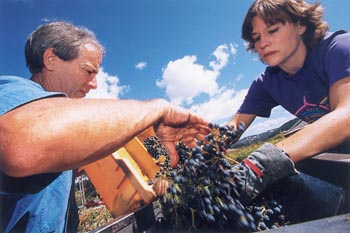
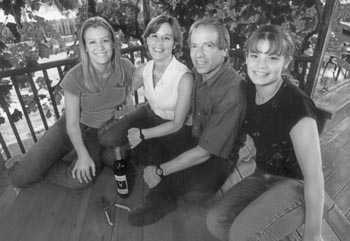
Michael Amsler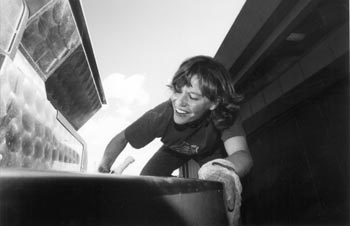
Michael Amsler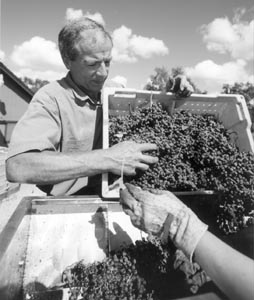 Crush story: Don Albini throws newly picked merlot grapes into the crusher.
Crush story: Don Albini throws newly picked merlot grapes into the crusher.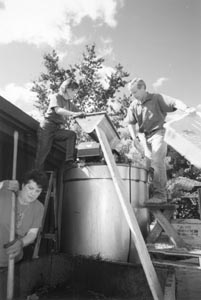 Sonoma County crushers: Lynne and Don Albini, working hard for their wine.
Sonoma County crushers: Lynne and Don Albini, working hard for their wine.
From the November 5-11, 1998 issue of the Sonoma County Independent.
![[MetroActive Dining]](/gifs/dining468.gif)